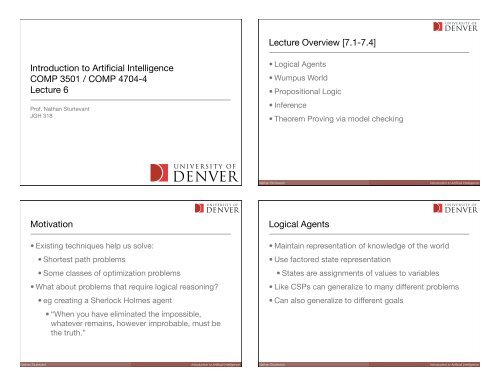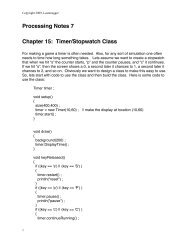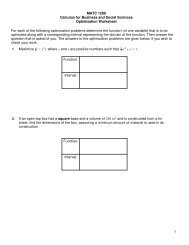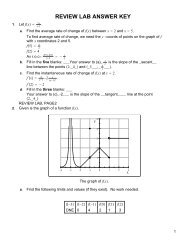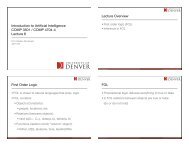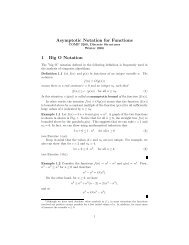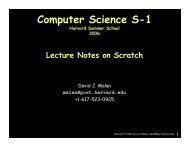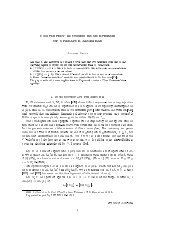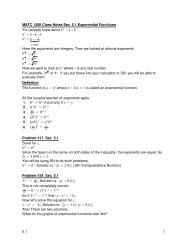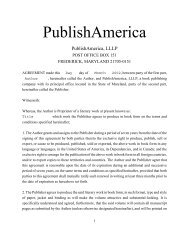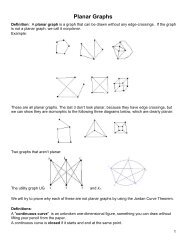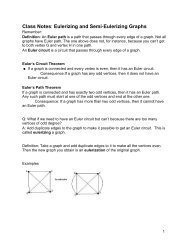Propositional Logic
Propositional Logic
Propositional Logic
Create successful ePaper yourself
Turn your PDF publications into a flip-book with our unique Google optimized e-Paper software.
Lecture Overview [7.1-7.4]Introduction to Artificial IntelligenceCOMP 3501 / COMP 4704-4Lecture 6Prof. Nathan SturtevantJGH 318• <strong>Logic</strong>al Agents• Wumpus World• <strong>Propositional</strong> <strong>Logic</strong>• Inference• Theorem Proving via model checkingNathan SturtevantIntroduction to Artificial IntelligenceMotivation• Existing techniques help us solve:• Shortest path problems• Some classes of optimization problems• What about problems that require logical reasoning?• eg creating a Sherlock Holmes agent• “When you have eliminated the impossible,whatever remains, however improbable, must bethe truth.”<strong>Logic</strong>al Agents• Maintain representation of knowledge of the world• Use factored state representation• States are assignments of values to variables• Like CSPs can generalize to many different problems• Can also generalize to different goalsNathan SturtevantIntroduction to Artificial IntelligenceNathan SturtevantIntroduction to Artificial Intelligence
α = KBß = No pit in [2, 2]Entailment• This shows how entailment can be used to deriveconclusions about the world• Performing logical inference• Model checking• Generate all possible models• Must be a finite number of models• Check if hypothesis is trueNathan SturtevantIntroduction to Artificial IntelligenceInference• KB !i α• α is derived from KB by inference algorithm i• A sound inference algorithm only derives entailedsentences• A complete inference algorithm can derive anyentailed sentence• Model checking is sound & complete (when applicable)<strong>Propositional</strong> <strong>Logic</strong>• Simple form of logic• Can seem limited, but more complex forms of logic canbe reduced to propositional logicNathan SturtevantIntroduction to Artificial IntelligenceNathan SturtevantIntroduction to Artificial Intelligence
<strong>Propositional</strong> <strong>Logic</strong>: Symbols• Not: ¬• And: ∧• Or: ∨• Implies: or →• If and only if: Prop. <strong>Logic</strong> Syntax• Sentence → AtomicSentence | ComplexSentence• AtomicSentence → True | False | P | Q | R | …• Complex Sentence → (Sentence) | [Sentence]| ¬ Sentence | Sentence ∧ Sentence| Sentence ∨ Sentence | Sentence Sentence| Sentence Sentence• Operator precedence: ¬, ∧, ∨, , Nathan SturtevantIntroduction to Artificial IntelligenceNathan SturtevantIntroduction to Artificial IntelligenceProp. <strong>Logic</strong> SemanticsSemantics• A model fixes the values of all variables to true or false• True/False are always True/False• Variables have their values defined in a model• ¬P is true iff P is false in model• P∧Q is true iff P and Q are both true in model• P∨Q is true iff P or Q are both true in model• PQ is true iff P is false or P&Q are both true in model• and not strictly needed• AB is the same as ¬ A ∨ B• AB is the same as (AB)∧(BA)• PQ is true iff P&Q have the same values in modelNathan SturtevantIntroduction to Artificial IntelligenceNathan SturtevantIntroduction to Artificial Intelligence
Construct WW KB• Px, y is true if there is a pit in [x, y]• Wx, y is true if there is a wumpus in [x, y]• Bx, y is true if the agent perceives breeze in [x, y]• Sx, y is true if the agent perceives stench in [x, y]Nathan SturtevantIntroduction to Artificial IntelligenceWW KB• There is no pit in [1, 1]• R1: ¬P1, 1• A square is breezy iff there is a pit in a neighboringsquare• R2: B1,1 (P1,2 ∨ P2,1)Prop. <strong>Logic</strong>: Simple inference• How many variables? How many models?• In how many is KB true?• R3: B2,1 (P1,1 ∨ P2,2 ∨ P3,1)• Percepts:• R4: ¬B1,1• R5: B2,1Nathan Sturtevant270Introduction to Artificial IntelligenceNathan SturtevantIntroduction to Artificial Intelligence
Selection of possible modelsSimple model checkingB11 B21 P11 P12 P21 P22 P31 R1 R2 R3 R3 R5 KB• How could we turn this into an algorithm?• What is the running time?F F F F F F FF T F F F F TF T F F F T FF T F F F T TNathan SturtevantIntroduction to Artificial IntelligenceHomework: 7.2


